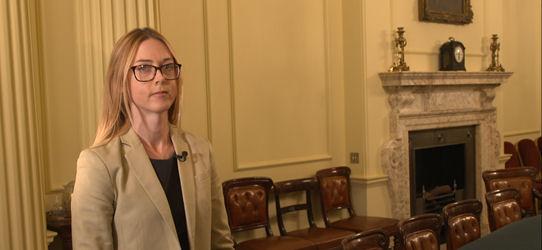Dr Niamh Gallagher speaks to Irish broadcaster to mark centenary of Anglo-Irish Treaty

Dr Niamh Gallagher, Associate Professor in Modern British and Irish History, spoke to Irish national broadcaster RTÉ to mark the centenary of the Anglo-Irish Treaty signed on 6 December 1921. Speaking in the Cabinet Room at 10 Downing Street where the final signatures were added to the document, the interview between Dr Gallagher and presenter David McCullagh was on the Six One News on Monday 6th December, at 6 p.m.
The Anglo-Irish Treaty – officially named ‘Articles of Agreement for a Treaty between Great Britain and Ireland’ – was a significant moment in the history of British-Irish relations. It was signed in the period of a truce between Irish republicans and Crown Forces. Both groups had been in conflict since January 1919 in a conflagration commonly remembered by Irish nationalists as the ‘War of Independence’ or, in the terminology of British politicians, the Irish ‘troubles’, reflecting different perspectives around sovereignty and violence. From October to December 1921, British and Irish representatives negotiated a settlement, the results of which, while lauded by many in Britain across the political spectrum, resulted in bitter civil war in Ireland in the months that followed. The Treaty created the Irish Free State, a 26-county Dominion within the British Empire.
The Cabinet Room at 10 Downing Street is a highly significant location. 100 years ago, it marked the centre of British imperial power. The Irish representatives, led by Arthur Griffith (the founder of Sinn Féin, an Irish republican party meaning ‘Ourselves Alone’ which had risen to electoral dominance in the December 1918 UK general election) and Michael Collins (a former Post Office clerk turned Minister of Finance in the new Irish government and Director of Intelligence for the Irish Republican Army), went to London alongside a wider team of experts, clerks and typists as plenipotentiaries for Sinn Féin. Their British counterparts included a pantheon of famous political leaders in Britain’s twentieth century, notably David Lloyd George (the Liberal prime minister since December 1916 at the head of a unionist-dominated coalition), Winston Churchill (Secretary of State for the Colonies), and Austen Chamberlain (head of the Conservative Party and Leader of the House of Commons). The Irish were grossly outmatched by the experience of the British representatives and profoundly different levels of power.
The sticking points for all involved were on the issues of the Crown, the Empire and Northern Ireland. From the moment negotiations began, the Irish representatives’ aspiration for a 32-county Irish Republic evaporated. Though the British representatives demonstrated flexibility on some of their red lines, there was no movement on the question of Ireland remaining within the British Empire with the monarch at its head. It was fundamentally the question of pledging loyalty to the monarch – commonly remembered in Ireland as ‘the Oath of Allegiance’ – that proved the most controversial point when the Irish representatives returned to Dublin to debate the Treaty in the Irish parliament. It would prove the fault line over which Sinn Féin would split and the civil war would emerge. The question of Northern Ireland, created the previous year under the Government of Ireland Act 1920, also spelled division. Historians disagree on whether the British budged on the issue. A clause was inserted on the Treaty that provided for a Boundary Commission to address the precise delineation of the border between ‘North’ and ‘South’. In the end, the Commission’s report was suppressed and no changes were made.
In the aftermath of civil war, the political parties that emerged in the Irish Free State were forged on pro- and anti- Treaty lines. Cumann na nGaedheal, later renamed Fine Gael, represented the pro-Treatyites, while Fianna Fáil (meaning ‘The Republican Party’) represented the anti-Treaty supporters. Since 2020, both parties, in conjunction with the Green Party, form a coalition government in the Republic of Ireland: the first time both parties have been in coalition together. Northern Ireland, which remains in the UK, and the Free State – later the Republic of Ireland – comprise the administrations on the island today. Both trace their lineage to the legislation of 1920-1.
Watch the full report on @RTE at time stamp 16.55-26.06 https://www.rte.ie/player/series/rt%C3%A9-news-six-one/SI0000001474?epguid=IH000399085
